Tank "Panther"
"Panther" - certainly one of the most famous heavy tankswho took part in the second world war. The Soviet medium T-34 tank became the catalyst for the creation of this combat vehicle, which was not foreseen in the Wehrmacht’s tank weapons system. His appearance on the Eastern Front forced the German Ministry of Arms to suspend the work that Nepschel had been carrying out on a promising 1937-ton tank since 30. On July 18, 1941, Rheinmetall received an order to develop a 75 mm long-barreled gun capable of piercing 140 mm armor at a distance of 1000 m. On November 25, Daimler-Benz and MAN were, in turn, issued an order for a 35-ton tank. The tactical and technical requirements for the new combat vehicle were determined by the following: width up to 3150 mm, height - 2990 mm, engine power of 650-700 hp, armor protection - 40 mm, maximum speed - 55 km / h. The assignment received a conditional name - "Panther".
The tank, designed by Daimler-Benz, outwardly strongly resembled the T-34, but nevertheless liked Hitler. From the Soviet car was completely copied layout with rear engine-transmission compartment of the first compartment and the drive wheels. Eight large-diameter road wheels were staggered, blocked in two and had leaf springs as an elastic suspension element. It was supposed to use a diesel engine Daimler-Benz MB 507 on the tank. In early February, 1942, the construction of the prototype began - VK 3002 (DB), and four weeks later, Hitler ordered the Minister of Weapons Speer to issue an order for the first 200 machines to the company. However, the Führer’s point of view did not find understanding and support in the Ministry of Armaments, whose experts, not without reason, believed that in front-line conditions, the external resemblance to the T-34 could have caused the shelling of the tank with its own artillery. The project of the company MAN, which had a traditional German layout with the front of the transmission and drive wheels, seemed to them more preferable, although it was much more complicated. These differences have led to the formation of the so-called "Panther-Commission".
13 May 1942, Hitler was reported on the expert opinion on both projects; preference was clearly given to the tank company MAN. The Fuhrer was forced to agree with the opinion of experts, but he immediately put forward his own conditions: the first car needed to be made in July, and the next two - in August 1942. The price of one tank without weapons was 117 thousand Reichsmarks (for comparison, PzIII cost 96 163, and "Tiger" -250 800 marks).
The constructors of PzKpfw V (the name "Panther", without mentioning the army index, were entered by order of the führer only from February 27 1944) were the chief engineer of the MAN tank department of the company P. Wibicke and the engineer G. Knipkamp from the weapons improvement and testing department.
The first two tanks V1 and V2 (V - Versuch - experience), differing from each other in minor details, produced by September 1942. On November 3, one of the machines, with a model instead of a real tower, was shown to Speer at the training ground in Bad Burke. During the tests revealed significant deficiencies in the chassis. It took time to eliminate them, and this delayed the start of mass production. The order also provided for the production of 250 tanks in a fairly short time - by May 12 1943. In addition, Hitler received an unexpected order to equip the "Panther" with an 75-mm cannon with a barrel in 100 calibers. Fortunately (for the Germans, of course), this gun was not yet ready, and the Führer’s instructions didn’t stop the mass production of the tank.
The first serial "Panther" left the factory shop of the company MAN 11 January 1943. Tanks of the “zero” series (20 units) received the designation Ausf A. They had nothing in common with the same-name machines that were produced since September 1943. A characteristic feature of the first serial "Panther" was the commander's turret with a protrusion on the left side of the turret and a single-chamber muzzle brake of the gun. The tanks were equipped with engines Maybach HL210P45 and had frontal armor 60 mm thick. They were used only in the rear for crew training. Since February 1943, the designation of the machines in this series has changed to Ausf D1.
It is still impossible to say exactly why the first large-scale modification of the Panther received the designation D. It is possible that the letters B and C were reserved for other variants.
The PzKpfw V Ausf D tanks (in this and subsequent modifications, the index on the Wehrmacht combat vehicle marking system was the same - SdKfz171) differed slightly from the prototypes and the "zero" series. The changes affected mainly the commander’s turret and the muzzle brake of the gun - they acquired a more familiar “Panther” look. Frontal armor thickness increased to 80 mm. The tanks also installed a new AK-type transmission 7-200.
It should be noted that the commander's turret was similar to the Tigris turret on the first-generation 1943, later replaced with a new perimeter perimeter surveillance device and a special ring for installing the MG 34 anti-aircraft machine gun.
Mortars NbK 39 were fastened along the sides of the tower to launch smoke grenades of caliber 90 mm.
The armor of the tanks released in the second half of the year was covered with "tsimerit"; in addition, they were equipped with forgers made of 5-mm armor plates.
Characteristic features of the D-series machines (officially D2) include the absence of a ball mount course machine gun (it was placed inside the tank and inserted only into a narrow vertical slot closed by a hinged lid for firing), and the presence of a round hatch in the left side of the turret loopholes for firing from personal weapons in the sides and stern of the tower.
As already mentioned, the first batch of “panthers” was planned to be made by 12 on May 1943 of the year - the date was not chosen by chance, the German offensive near Kursk was to begin on May - Operation Citadel. However, during February and March, most of the 15 tanks were not accepted by the military, and in April they did not accept any at all. In this regard, the timing of the attack was postponed to the end of June. By the end of May, the Wehrmacht received the long-awaited 77 "Panthers", which allowed them to staff the 324-th tank brigade. But the problems that the TZF 10 complex binocular sight developed by the tank crews and the desire to commission more 12 tanks launched in June forced to move the start date of the offensive from 98 in June to 25 in July. So the difficulties with the production and development in the troops of the first "Panthers" affected the timing of the summer offensive on the Eastern Front in 5.
To make up for the losses incurred in the battles near Kursk, starting in August, a monthly production plan was set up - 250 Panthers. However, in August, only 120 tanks were made - as a result of the Allied bombing aviation MAN factories in Nuremberg and DaimIer-Benz in Berlin were badly damaged. It was not possible to fulfill the plan in September (197 vehicles), and only in October 257 tanks left the factory workshops!
Since September 1943, the release of the following modification of the Panther began - Ausf A. Not many changes have been made: a spherical installation of a course machine gun appeared in the front hull plate; eliminated hatch for ejection of spent cartridges and loopholes for firing from personal weapons in the sides of the turret; instead of two headlights, they began to install only one - on the left wing. The binocular sight was replaced with a monocular TZF 12. The angle of elevation of the tank gun was reduced from 20 ° (in Ausf D) to 18 °.
Modification Ausf G - the most massive of the three (manufactured 3740 tanks) - launched into mass production in March 1944 of the year. The hull side sheets received an angle of inclination in 61 ° (in D and A - 50 °), the thickness of the side armor increased to 50 mm, and the frontal armor of the tower - to 110 mm, the driver's hatch was removed from the front sheet. Landing hatches machine gunner and driver got another form. Some tanks received a cannon mask with a kind of "skirt" in the lower part, which made it impossible to jam the turret when hit by an enemy projectile. Three shots increased gun ammunition, changes were made to the design of the fans, engine louvers, exhaust pipes, etc. The G-series tanks were planned to be equipped with support rollers without rubber bands, but the complete absence of photographs of combat vehicles with such a chassis suggests that this project remained on paper. A car with non-rubberized ice rinks was built by MAN in September 1944. Some serial "panthers" had single non-rubber rollers on the last axis.
Experiments were conducted on the use of various engines on the Panther: MAN / Argus LD 220 with air cooling and horsepower 700. (515 kW), aviation star-shaped BMW 132D horsepower 650 hp (478 kW) diesel Daimler-Benz MB 507 horsepower 850 hp (625 kW).
New transmission options were tested - hydrostatic and hydrodynamic, underwater driving equipment and road wheels with internal depreciation. However, all these innovations have not found applications on production machines. The flame-throwing version of the Panther remained unrealized.
After the cessation of work on the reconnaissance tank VK 1602 "Leopard" firms Krupp and Rheinmetall began to design a version of the "Panther" of the same purpose. It was supposed to equip the car with a new turret with 50-mm gun KwK 39 L / 60. This project was not accepted, as its armament was deemed insufficient, and linear tanks were used for reconnaissance purposes.
The use by the allies of the anti-Hitler coalition in the ever-increasing volumes of aircraft to fight German tanks (especially after the opening of the second front in Europe) reduced the possibility of movement of tank units during the day to almost zero. There was an acute question about equipping tanks with night-vision devices, which AEG had been working on since 1936. An infrared searchlight-illuminator with a power of 200 W and a surveillance device that allowed to monitor the terrain at a distance of 200 m were mounted on the commander's turret of the Panther. The driver did not have such a device and drove the car, guided by the commander’s instructions. To fire at night, a more powerful illuminator was needed. For this purpose, an Uhu infra-red illuminator with 250 kW power was installed on the SdKfz 20 / 6 semi-tracked armored personnel carrier to operate the 700 m night vision device. The tests were successful, and Leitz-Wetzlar manufactured 800 optics kits for nightly devices. In November, 1944, the Pantservae received the 63 Panthers, equipped with the world's first serial passive night vision devices. Zeiss-Jena developed an even more powerful device that allowed to “see” at a distance of 4 km, but because of the large size of the illuminator - the diameter of 600 mm - the application on the Panther tank did not find it.
In 1943, the design of the next modification of the Panther, the Ausf F, began, which was significantly different from previous models. The most important innovation was the tower, called Schmalturm ("narrow" or "cramped tower"), which was less standard and had a different design.
During 1944, several prototypes were manufactured and tested. The design ended only in January 1945.
As a result, the tower’s armor thickness was: forehead - 100 mm, board and stern - 50, roof - 30. In the frontal list there was still an embrasure for the TZF 13 telescopic sight. In the final version, frontal armor increased to 120 mm, airborne - to 60, and roof armor - to 40. Installed a new stabilized periscope sight TZF 1 and stereoscopic rangefinder company Zeiss. The range finder with a base 1320 mm and 15-fold magnification was located in front of the tower, on the sides of which there were armor caps for its eyepieces. Provided for the installation of a night vision device FG 1250.
The mask of the Saukopfblende type gun ("pig nose") 120 mm thick was similar to that used on the Tiger II tank.
Innovations have not bypassed the tank armament. And if the gun remained the same and was only modernized at the Skoda plants - it lost the muzzle brake and received the KwK 44 / 1 index, then the MG 34 turret gun was replaced with the MG 42. Instead of a course machine gun, the MP 44 was installed. Installation of weapons in the tower was carried out at the Krupp and Skoda plants.
The changes affected not only the tower, but also the hull. The thickness of the roof was increased from 17 to 25 mm, changed the hatches of the driver and gunner-radio operator.
Two new engines were also tested: Deutz T8M118 with 700 horsepower. (515 kW) and Maybach HL 234 with direct fuel injection and horsepower 850 hp (625 kW).
Until the end of the war, not a single prototype appeared in its final form, although it was planned to start mass production in June of 1945. At the beginning of the year, Daimler-Benz assembled a chassis on which a standard Ausf G tower was installed. In turn, the “cramped tower” was installed on the Ausf G chassis and tested in Kummersdorf. In total for the "Panther" Ausf F manufactured 8 buildings and 2 towers.
In February, the tactical and technical requirements for the Panther II tank, which assumed a high degree of unification of the Tiger II and Panther tanks, were developed by 1943. It turned out to be quite easy to carry out, since both types of machines were manufactured at Henschel’s factories.
On the "Panther II" was supposed to use the "cramped tower" and the new building. His frontal armor reached 100, onboard - 60, and aft - 40 mm. Armament - 88-mm gun KwK 43 L / 71. Since in this case the mass of the tank exceeded the 50 T, the question arose of a new power plant. As options were considered engines Maybach HL 234, Simmering Sla 16 (720 hp) and MAN / Argus LD 220 (700 hp). In the 1945, the Panther II began designing a new tower with 150-mm frontal armor.
None of the two prototypes was completed. One chassis was brought to a more or less high degree of readiness by installing an Ausf G turret on it. It is interesting to note that, in parallel with the design of the Panther II, the E-50 tank was being developed to replace it.
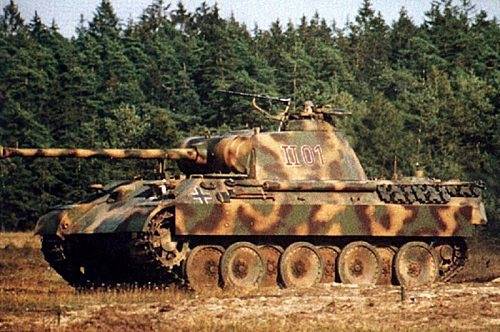
In the process of working on the Ausf F and the Panther II, Krupp has twice offered options for retrofitting the conventional Panther with a KwK 43 L / 71 X-mmX caliber gun, but to no avail. The Panther’s 88-caliber 100-mm gun design with the initial velocity of the 75 projectile, m / s, remained on paper.
Along with the creation of new variants of the linear tank on the basis of the "Panther", several special-purpose vehicles were also produced. The first of these was the armored recovery vehicle (BREM) Bergepanzer V or Bergepanther (SdKfz 179). And not by chance: new tanks were delivered to the troops, and there was practically no means for evacuating them from the battlefield. The existing machinery turned out to be too weak - for towing a Tiger tank, for example, it was necessary to “harness” two Famo 18-ton tractors.
The order for the BREM was issued on 7 on May 1943 of the year, and a month later, MAN began production of the Ausf D chassis intended for it. The first batch of BREM (46 machines) did not have a crane and a winch, but very soon a crane and a winch with a pull force of 40 and cable length 150 were developed and manufactured at the Henschel plant in Kassel. The power was taken from the engine of the tank, aft which there were two folding end-opener designed to hold the machine in place during operation of the winch. During towing last blocked. The tower was replaced with a cargo platform for the transport of spare parts or dismantled units.
BREM, released on the chassis Ausf A and Ausf G, had increased fuel tanks. A bracket for an 20-mm KwK 38 gun, covered with a 10-15 mm thick shield, was mounted on the upper front hull sheet.
"BREM-Panthers" were initially equipped with cranes with a load capacity of 1500 kg, and then 6000 kg. They were used mainly for dismantling engines.
In front of the BREM had two stops with tabs of solid wood, for pushing narrower machines.
1 March 1944 of the year at the Bad Berk Bergepanther training ground was demonstrated to Colonel-General Guderian, Inspector General of Tank Forces. 7 April Hitler gave orders for the monthly production of 20 machines. However, the real output was in April 13 machines, in May - 18, in June - 20, and in July - only 10. In total, the factory shops left 347 Bergepanther (another number is found in foreign literature - 297).
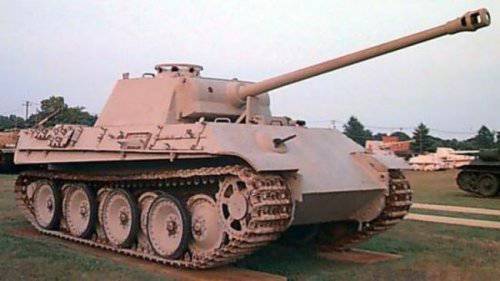
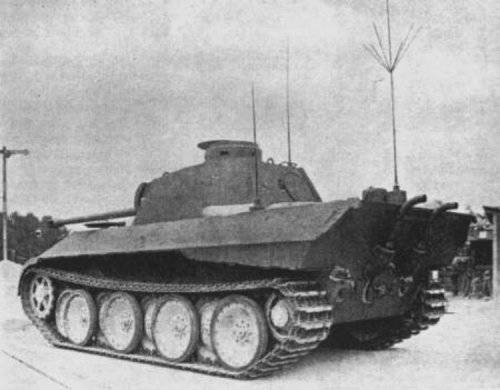
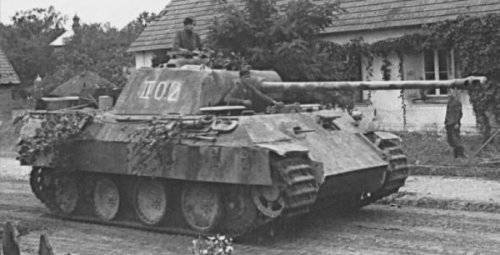
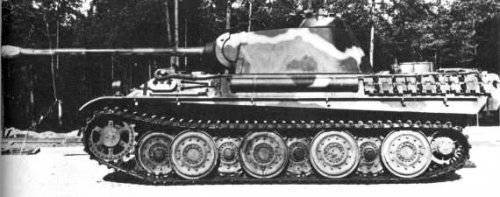
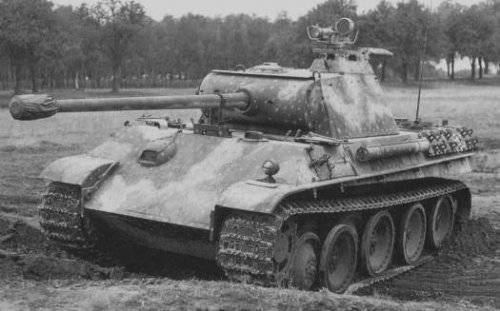
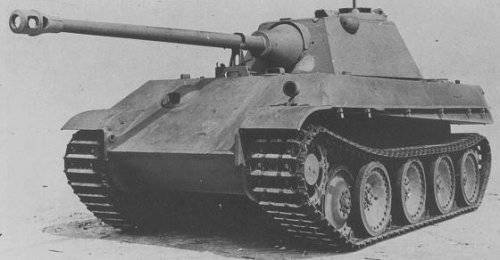
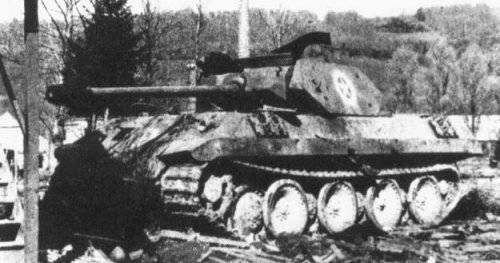
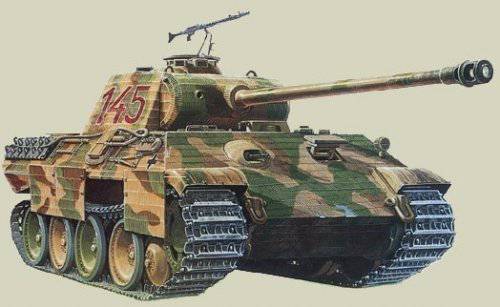
Information